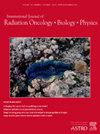The Fragility of Phase III Trials in Oncology
IF 6.4
1区 医学
Q1 ONCOLOGY
International Journal of Radiation Oncology Biology Physics
Pub Date : 2024-10-01
DOI:10.1016/j.ijrobp.2024.07.063
引用次数: 0
Abstract
Purpose/Objective(s)
The standard of care for oncologic treatment is often established and refined through randomized phase III clinical trials. While the success of a trial is generally established through meeting statistical significance, there are few metrics to measure the robustness of a trial’s outcomes. Using the survival-inferred fragility index (SIFI), we performed an assessment of the fragility of oncology clinical trials.
Materials/Methods
We established a database of 332 phase III oncology trials from 2002-2020 for which Kaplan-Meier curves were digitally reconstructed to accurately reproduce survival time and censoring at the individual level. SIFI values were established by counting the number of patients that needed to be iteratively flipped between treatment arms to cause a positive trial to lose statistical significance or for a negative trial to gain statistical significance. This number was then normalized as a percentage of the total trial enrollment. We calculated SIFI using flipping of best (longest) survivor from the intervention arm (SIFI_B), worst (shortest) survivor from the control arm (SIFI_W), and median survivor in the control arm (SIFI_M). Trials were classified based on whether they were testing immune-checkpoint inhibitors (ICIs), targeted therapies, or others. The Mann-Whitney U test was used to perform pairwise comparisons and the Kruskal-Wallis test was used for comparisons of more than 2 groups. Statistical analyses were performed in R.
Results
Of the 332 trials assessed, 196 were positive and 136 were negative. There were 190 targeted therapy trials, 52 ICI trials, and 90 trials assessing other agents. The most common primary endpoint was progression-free survival (PFS) (154 trials), followed by overall survival (OS) (136 trials). For all trials, the median SIFI_B was 1.37%, SIFI_W was 1.71%, and SIFI_M was 2.74%. A practice changing ICI trial was the PACIFIC trial, which had SIFI_B of 1.96%, SIFI_W of 1.40%, and SIFI_M of 1.82%. Targeted therapy trials were significantly more robust than ICI trials with SIFI_W of 1.93% vs 1.28% (P = 0.037) and SIFI_M of 3.14% vs 1.98% (P = 0.012). Trials assessing OS as the primary endpoint were significantly more fragile than trials with PFS as the overall endpoint (SIFI_B 0.90% vs. 1.78%, P < 0.001; SIFI_W 1.33% vs. 2.96%, P < 0.001; SIFI_M 2.13% vs. 4.58%, P < 0.001). Lastly, trials with negative outcomes were significantly more fragile than trials with positive outcomes (SIFI_B 1.08% vs. 1.68%, P < 0.001; SIFI_W 1.36% vs. 2.32%, P < 0.001; SIFI_M 2.21% vs. 3.70%, P < 0.001).
Conclusion
We found that targeted therapy trials, trials with PFS as the primary endpoint, and positive trials tend to be the most robust. Further work will need to validate the use of SIFI in designing more robust clinical trials.
肿瘤学 III 期试验的脆弱性
目的/目标:肿瘤治疗的标准通常是通过随机 III 期临床试验确立和完善的。虽然试验的成功一般是通过达到统计学意义来确定的,但很少有衡量试验结果稳健性的指标。材料/方法 我们建立了一个包含 2002-2020 年间 332 项 III 期肿瘤试验的数据库,对这些试验的 Kaplan-Meier 曲线进行了数字重建,以准确再现生存时间和个体水平的删减。SIFI值是通过计算需要在治疗臂之间反复翻转才能使阳性试验失去统计学意义或使阴性试验获得统计学意义的患者人数来确定的。然后将这一数字归一化为占试验总人数的百分比。我们通过翻转干预组的最佳(最长)存活者(SIFI_B)、对照组的最差(最短)存活者(SIFI_W)和对照组的中位存活者(SIFI_M)来计算 SIFI。试验的分类依据是它们是否在测试免疫检查点抑制剂(ICIs)、靶向疗法或其他疗法。成对比较采用 Mann-Whitney U 检验,两组以上比较采用 Kruskal-Wallis 检验。统计分析在 R 中进行。结果在评估的 332 项试验中,196 项为阳性,136 项为阴性。其中有 190 项靶向治疗试验、52 项 ICI 试验和 90 项评估其他药物的试验。最常见的主要终点是无进展生存期(PFS)(154 项试验),其次是总生存期(OS)(136 项试验)。在所有试验中,SIFI_B 的中位数为 1.37%,SIFI_W 为 1.71%,SIFI_M 为 2.74%。PACIFIC试验改变了ICI试验的做法,该试验的SIFI_B为1.96%,SIFI_W为1.40%,SIFI_M为1.82%。靶向治疗试验明显比 ICI 试验更稳健,SIFI_W 为 1.93% vs 1.28% (P = 0.037),SIFI_M 为 3.14% vs 1.98% (P = 0.012)。以OS为主要终点的试验明显比以PFS为总终点的试验更脆弱(SIFI_B 0.90% vs. 1.78%, P < 0.001; SIFI_W 1.33% vs. 2.96%, P < 0.001; SIFI_M 2.13% vs. 4.58%, P < 0.001)。最后,阴性结果的试验明显比阳性结果的试验更脆弱(SIFI_B 1.08% vs. 1.68%,P < 0.001;SIFI_W 1.36% vs. 2.32%,P < 0.001;SIFI_M 2.21% vs. 3.70%,P < 0.001)。在设计更稳健的临床试验时,需要进一步验证 SIFI 的使用。
本文章由计算机程序翻译,如有差异,请以英文原文为准。
求助全文
约1分钟内获得全文
求助全文
来源期刊
CiteScore
11.00
自引率
7.10%
发文量
2538
审稿时长
6.6 weeks
期刊介绍:
International Journal of Radiation Oncology • Biology • Physics (IJROBP), known in the field as the Red Journal, publishes original laboratory and clinical investigations related to radiation oncology, radiation biology, medical physics, and both education and health policy as it relates to the field.
This journal has a particular interest in original contributions of the following types: prospective clinical trials, outcomes research, and large database interrogation. In addition, it seeks reports of high-impact innovations in single or combined modality treatment, tumor sensitization, normal tissue protection (including both precision avoidance and pharmacologic means), brachytherapy, particle irradiation, and cancer imaging. Technical advances related to dosimetry and conformal radiation treatment planning are of interest, as are basic science studies investigating tumor physiology and the molecular biology underlying cancer and normal tissue radiation response.

 求助内容:
求助内容: 应助结果提醒方式:
应助结果提醒方式:


